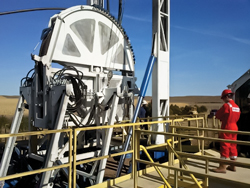What's new in production
The Niobrara formation—today it’s all about liquids, but gas will have its encore
The Niobrara is a river that starts in Wyoming and crosses Nebraska before losing itself in the Missouri River, just north of the hamlet of Niobrara, population 370 (and still growing). The word comes from the Omaha language and means, approximately, “flowing water” (the Omaha word for “flat water” is “Nebraska”). Niobrara is also the name of an extensive geologic formation, the interesting parts of which underlie a big chunk of northeastern Colorado, and pieces of Wyoming, Nebraska and Kansas. The hydrocarbon-bearing portions of the Niobrara formation are found in the Denver-Julesburg basin (a.k.a. “the DJ”), a gas-prone area in the northeast corner of Colorado and southwest Kansas, and the North Park basin, which has shown a lot of recent potential for crude oil. (Yes, there is a South Park basin—it has seen a lot of gold mining, but not much oil or gas.) There is also the Piceance basin to the west. The Niobrara has been the shy stepsister of more popular shale plays—the Marcellus, the Eagle Ford and especially the Bakken, to which it has often been compared. It is sometimes referred to as the “Niobrara shale,” but it is actually quite a bit more complicated than that. In addition to calcareous shale, there is considerable clay, marl (mudstone), limestone and chalk. As geologist Jack Wiener told the Rocky Mountain Association of Geologists last month, “the layers of complexity of [the Niobrara] could fill the room.” Enthusiasm for the Niobrara has risen with the price of oil. In October 2009, EOG Resources drilled a horizontal well known as the Jake, which produced some 50,000 bbl of crude in its first three months. Another success, drilled by Noble Energy in 2010, was called Gemini. Something of a land rush ensued, which is continuing today, with ConocoPhillips, Anadarko, Chesapeake and many independents scrambling to obtain leases. On the one hand, the oil deposits have proven complex, spotty and hard to predict. On the other hand—$105 a barrel (as this issue was going to press). Natural gas in the Niobrara is a long-term story. Production has been growing—Colorado, alone, has a whopping 30,000 gas producers, and Kansas has another 24,000. But gas is a victim of its own success, as supplies surge and prices drop. Taking the optimistic view, natural gas consumption is growing, and some day in the finite future, prices will rebound. In the meantime, obviously, anything that helps reduce drilling costs is welcome. AnTech Ltd., along with Advanced Drilling Technologies (ADT), has recently completed a five-well test in the Niobrara formation near the Kansas-Colorado border, utilizing coiled tubing and a bottomhole assembly (BHA) featuring a new electric orientation tool. The reservoirs are very shallow in this part of the Niobrara, on the order of 1,000–3,000 ft. The POLARIS is a BHA with a 5-in. diameter. Instead of rotary steerable, AnTech used a simpler, much less expensive gyro-based directional measurement system. The plan was to drill the three directional wells at 6½-in. diameter. The first was an S-shaped well, and the second well was directionally drilled to about 1,500 ft TVD, with an average dogleg severity of 7.5 degrees. The third was drilled to over 1,100 ft with a 700-ft horizontal displacement. AnTech managing director Toni Miszewski told World Oil, “The fundamental issue with coiled tubing is that you can’t rotate it from surface. So you have to have some means to rotate a bent motor in the direction you want to go. The device we have for that is an electric orienter. So we can control the direction the bit is pointing, even though the coil itself can’t be rotated.” The tool is controlled by wireline, which runs down the inside of the coil, providing both power and communication to the tool. The operator can control where the bit is pointing and make measurements of exactly where it is in 3D space. That’s controlled with a PC server arrangement at surface, in the doghouse. The POLARIS BHA, only 15 ft long, includes the rotating joint, the gyro system and sensors. These are connected to a drill motor with a bent sub and drill bit. The rotating joint orients the tool for the build section, and by continuous rotation, the driller can keep a straight hole. The fourth and fifth wells were 6.25-in. horizontals with 8.5-in. build sections. “With these two particular wells, we had to drill underbalanced with air,” said Miszewski. “There are fractures in those wells, which means that they won’t hold a column of fluid. You can’t use a liquid mud or you end up just pumping and pumping, and you lose your fluid into the formation. So you have to drill it with air, underbalanced.”
Since they were drilling into gas formations, there was always the potential of having gas coming out at the same time. By drilling with coiled tubing, it was easier to keep control of the well, and easier to drill in an underbalanced condition. That’s an environmental benefit. Also, with no people on the drill floor, there is a safety advantage. But the real “killer app” for using the POLARIS BHA and coiled tubing, Miszewski’s said, “is the speed. It’s not the answer to every drilling problem, but it can do faster drilling really, really well, because you don’t have to make up the joints, and the tool keeps you on target. That affects the final dollar amount.“
|
- What's new in production (February 2024)
- Prices and governmental policies combine to stymie Canadian upstream growth (February 2024)
- U.S. operators reduce activity as crude prices plunge (February 2024)
- U.S. producing gas wells increase despite low prices (February 2024)
- U.S. drilling: More of the same expected (February 2024)
- U.S. oil and natural gas production hits record highs (February 2024)
- Applying ultra-deep LWD resistivity technology successfully in a SAGD operation (May 2019)
- Adoption of wireless intelligent completions advances (May 2019)
- Majors double down as takeaway crunch eases (April 2019)
- What’s new in well logging and formation evaluation (April 2019)
- Qualification of a 20,000-psi subsea BOP: A collaborative approach (February 2019)
- ConocoPhillips’ Greg Leveille sees rapid trajectory of technical advancement continuing (February 2019)




